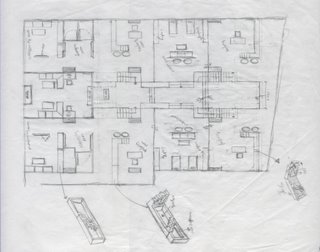Dress - sketches




Body, Space and Philosophy
Book: The Primacy of Perception
Chapter: Eye and Mind
Author: Maurice Merleau-Ponty
“The body’s animation is not the assemblage or juxtaposition of its parts. Nor is it a question of a mind or spirit coming down from somewhere else into an automaton; this would still suppose that the body itself is without an inside and without a “self.” There is a human body when, between one eye and the other, between hand and hand, a blending of some sort takes place – when the spark is lit between sensing and sensible…”
The definition of a body is not the physical structure or combination of organs such as: heart, lungs, hands, stomach, etc. The real human body is also not defined as some spirit that moves the physical body, which is empty inside. Even to a Cartesian, body is seen as a dummy or an “outside[1]”. It means that it is only acts as a shell for the real “body”.
A body exists “when, between one eye and the other, between hand and hand, a blending of some sort takes place”. The body consists of senses such as: eyes, hands, mouth, etc. These senses allow us to experience the world and to know the world. These senses must work together harmoniously with each other and work hand in hand. When these senses work, they give out something to the world or the sensible and in return, the world gives back to our senses. Therefore, a body is an experience of interaction with the world using our senses as a whole and not as individual.
This experience of senses happens inside space and time. It is able to take place as body experience changes. For example: when we touch and apple, our hand moves and changes occur. These are evidence that time is involved because when something is in time, it succumb to changes. As the time is involved in the body, space must also be there. Space is defined as having the three elements of dimensions, which are height, width and depth. According to Maurice Merleau-Ponty, depth is what makes space exist. Being “derived from the other two[2]”, depth has both height and width inside it, and thus it is “no longer a dimension” but it is “the experience of the reversibility of dimensions[3]”. For example: a picture is flat and does not have the element of depth in it. It is not able to experience changes but the real world has it and it gives a sense of distance to an object and give volume to it. It is now able to make dimensions change.
Therefore, our experience of sensing the world can only occurred and contained in a changing environment, which is inside space and time.
[1] “A Cartesian does not see himself in the mirror; he sees a dummy, an “outside.” Which, he has every reason to believe, other people see in the very same way but which, no more for himself than for others, is not a body in the flesh.” (Merleau-Ponty,M., 1964, p.170)
[2] “The picture is a flat thing contriving to give us what we would see in the [actual] presence of “diversely contoured” things, by offering sufficient diacritical signs of the missing dimension, according to height and width. Depth is a third dimension derived form the other two.” (Merleau-Ponty,M., 1964, p.170)
[3] “Depth thus understood is, rather, the experience of the reversibility of dimensions, of a global “locality” – everything in the same place at the same time, a locality from which height, width and depth are abstracted, of a voluminosity we express In a word when we say that a thing is there.” (Merleau-Ponty,M., 1964, p.170)
No comments:
Post a Comment